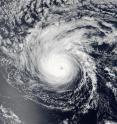NASA sees Lester move into central Pacific Ocean basin
Hurricane Lester continues to march to the west and NASA-NOAA's Suomi NPP satellite saw the storm as it was crossing from the Eastern Pacific to the Central Pacific Ocean and triggered new hurricane watches for Hawaii. When a tropical cyclone crosses the 140 degree west longitude line, it has moved into the Central Pacific Ocean and warnings on the system will be issued by NOAA's Central Pacific Hurricane Center (CPHC).
On Aug. 31 at 6:50 p.m. EDT (22:50 UTC) the Visible Infrared Imaging Radiometer Suite (VIIRS) instrument aboard NASA-NOAA's Suomi NPP satellite provided a visible image of Hurricane Lester. Lester's eye was still visible although some high clouds had filtered into it. The VIIRS image showed that Lester's eye was surrounded by powerful thunderstorms. By 11 p.m. EDT, Lester had crossed into the Central Pacific Ocean basin.
On Sept. 1, NOAA's CPHC noted that a Hurricane Watch is in effect for Hawaii County, Maui County including the islands of Maui Molokai Lanai and Kahoolawe.
CPHC said that hurricane conditions are possible over Hawaii and Maui counties Saturday, Sept. 3. Ocean swells generated by Lester will start to build over east facing shores today and Friday. Surf will peak this weekend, becoming very large and damaging along east facing shores. Heavy rains associated with Lester may reach Hawaii and Maui counties on Saturday, and may affect other Hawaiian Islands later Saturday and Sunday.
At 11 a.m. EDT (5 a.m. HST/1500 UTC, the center of Hurricane Lester was located near 18.4 degrees north latitude and 143.7 west longitude. That puts Lester's eye about 750 miles (1,205 km) east of Hilo, Hawaii, and 945 miles (1,520 km) east of Honolulu. The estimated minimum central pressure is 971 millibars.
Lester is moving toward the west near 14 mph (22 km/h) and this motion is expected to become west northwest later today through early Saturday, Sept. 3. Maximum sustained winds are near 105 mph (165 kph) with higher gusts. Some weakening is forecast through early Saturday.
Source: NASA/Goddard Space Flight Center
Articles on the same topic
- NASA sees Hurricane Lester approaching Hawaiian IslandsFri, 2 Sep 2016, 17:06:25 UTC
- NASA sees a weaker Tropical Storm Madeline passing south of Hawaii's Big IslandThu, 1 Sep 2016, 16:26:36 UTC
- Satellites show Hurricane Madeline weakening upon approach to HawaiiWed, 31 Aug 2016, 20:04:10 UTC
- NASA's GPM examines Category Four Hurricane LesterWed, 31 Aug 2016, 16:06:48 UTC
- NASA satellite catches major Hurricane Madeline as Hawaii bracesTue, 30 Aug 2016, 17:15:37 UTC
- NASA looks at Eastern Pacific's Category 3 Hurricane LesterTue, 30 Aug 2016, 17:15:25 UTC
Other sources
- Lester downgraded to tropical depression in Pacificfrom UPISun, 4 Sep 2016, 21:21:15 UTC
- NASA sees Hurricane Lester approaching Hawaiian Islandsfrom PhysorgFri, 2 Sep 2016, 18:31:24 UTC
- Hawaiian islands prepare for Hurricane Lesterfrom UPIFri, 2 Sep 2016, 10:31:25 UTC
- NASA sees Lester move into central Pacific Ocean basinfrom PhysorgThu, 1 Sep 2016, 17:32:01 UTC
- NASA sees a weaker Tropical Storm Madeline passing south of Hawaii's Big Islandfrom PhysorgThu, 1 Sep 2016, 17:31:54 UTC
- Hawaii avoids direct hit from Tropical Storm Madeline; Hurricane Lester loomsfrom UPIThu, 1 Sep 2016, 11:31:28 UTC
- Hawaii declares emergency as it prepares for first Hurricane hit since 1949from UPIThu, 1 Sep 2016, 1:01:18 UTC
- Satellites show Hurricane Madeline weakening upon approach to Hawaiifrom PhysorgWed, 31 Aug 2016, 22:31:23 UTC
- Cameras On The ISS Capture Gorgeous Time-Lapse Footage Of Three Hurricanesfrom PopSciWed, 31 Aug 2016, 19:31:13 UTC
- 3 for 1: Space Station Eyes Hurricanes Lester, Madeline and Gastonfrom Space.comWed, 31 Aug 2016, 18:41:22 UTC
- 3 for 1: Space Station Eyes Hurricanes Lester, Madeline and Gastonfrom Live ScienceWed, 31 Aug 2016, 18:41:21 UTC
- NASA's GPM examines Category Four Hurricane Lesterfrom PhysorgWed, 31 Aug 2016, 16:01:40 UTC
- Madeline weakens to Category 1 but still headed for Big Islandfrom UPIWed, 31 Aug 2016, 13:31:24 UTC
- Hurricane Madeline weakens to category 3, but still packing punch near Hawaiifrom UPIWed, 31 Aug 2016, 1:01:15 UTC
- Three Hurricanes Seen From Space Station On Same Day | Time-Lapse Videofrom Space.comTue, 30 Aug 2016, 21:11:20 UTC
- Three Hurricanes Seen From Space Station On Same Day | Time-Lapse Videofrom Live ScienceTue, 30 Aug 2016, 20:41:18 UTC
- NASA looks at Eastern Pacific's Category 3 Hurricane Lesterfrom PhysorgTue, 30 Aug 2016, 17:11:45 UTC
- NASA satellite catches major Hurricane Madeline as Hawaii bracesfrom PhysorgTue, 30 Aug 2016, 17:11:44 UTC
- Madeline strengthens into Category 4 hurricane, heads toward Hawaiifrom UPITue, 30 Aug 2016, 16:41:26 UTC
- Madeline strengthens into category 4 hurricane; heading toward Hawaiifrom UPITue, 30 Aug 2016, 15:41:20 UTC
- NASA spots Central Pacific's Madeline strengthening into a hurricanefrom PhysorgMon, 29 Aug 2016, 19:01:30 UTC
